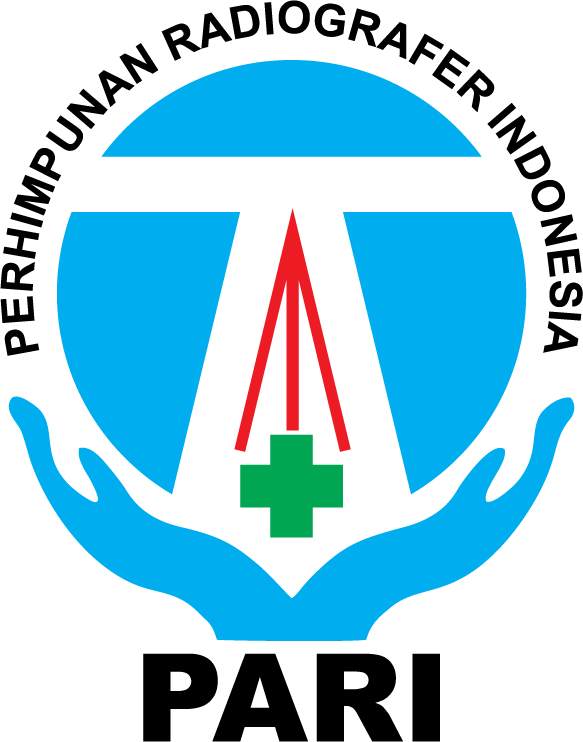Optimalisasi Tegangan Tabung (KvP) Terhadap Kejelasan Informasi Anatomi Dan Dosis Radiasi Pada Pemeriksaan CT Scan Kepala Area Basis Cranii
Abstract
Background: Tube voltage (kVp) is one of the exposure factors on a head CT scan that can be varied to achieve a minimal radiation dose. Radiology installation of Bhakti Wira Tamtama hospital has a new CT scan modality that never variation its tube voltage. The variation of tube voltage is 80 kVp, 100 kVp, and 120 kVp. The aim of this research is to know and to analyse the most optimize tube voltage which can produce the best anatomy clarity and has the lowest radiation dose on a head CT scan examination of the base skull area that dominates CT scan examination.
Methods: This research is descriptive analytic research conducted with an experimental approach. The study was conducted by varying the tube voltage to be used for head CT scan examination. There are 3 variations of tube voltage 80 kVp, 100 kVp, and 120 kVp where one variation contains 16 images for analyzing the clear anatomy of the base skull area. Then assessed by radiologists as the respondent. Data was analyzed by scoring where score 1 is not clear, score 2 is clear and score 3 is very clear. Radiation dose was obtained from CTDI and DLP records.
Results: The results showed that there is no difference in anatomy clarity between variation of three tube voltage with p value 0,135. The anatomical clarity assessed includes anterior skull base, central skull base (fossa cranial middle, sphenoid, temporal bone, petrosous ridge), anterior clinoid processes, posterior margin of the lesser sphenoid wings, anterior and superior rim of the greater sphenoid wings, mastoid, and posterior skull base. All of them is very clear at 100 kVp and 120 kVp with value 100%. But at 80 kVp assessed clear at anterior and posterior skull base. So the value of anatomy clarity at 80 kVp is very clear only 71%. The effect of the difference in tube voltage on the radiation dose on a head CT scan of the base skull area showed a difference in the decrease in radiation dose from 120 kVp to 100 kVp for CTDI 39.9% and DLP 40.19%. There was a decrease in radiation dose from 100 kVp to 80 kVp for CTDI 52% and DLP 49.88%.
Conclusion: The tube voltage setting on head CT scan examination of the base skull area can be applied with 100 kVp because this is evidenced by the same total score at 100 kVp and 120 kVp, which is 100% is very clear, while at 80 kVp tube voltage only 71% is very clear. And the radiation dose at 100 kVp is lower than 120 kVp.
Keywords
Full Text:
PDFReferences
Almohiy, H. et al. (2016) ‘Correct Patient Centering Increases Image Quality without Concomitant Increase of Radiation Dose during Adult Intracranial Computed Tomography’, Journal of Medical Imaging and Radiation Sciences, 47(3), pp. 1–8. doi:10.1016/j.jmir.2016.05.002.
BAPETEN (2020) ‘Peraturan Badan Pengawas Tenaga Nuklir Nomor 4 Tahun 2020 tentang keselamatan radiasi pada penggunaa pesawat sinar-X dalam radiologi diagnostik dan intervensioal’, pp. 42–44.
Chawla, H. et al. (2015) ‘Diagnostic utility of conventional radiography in head injury’, Journal of Clinical and Diagnostic Research, 9(6), pp. 1–3. doi:10.7860/JCDR/2015/13842.6133.
Chilamkurthy, S. et al. (2018) ‘Deep learning algorithms for detection of critical findings in head CT scans: a retrospective study’, The Lancet, 392(10162), pp. 2388–2396. doi:10.1016/S0140-6736(18)31645-3.
Faried, A. et al. (2019) ‘Correlation between the skull base fracture and the incidence of intracranial hemorrhage in patients with traumatic brain injury’, Chinese Journal of Traumatology - English Edition, 22(5), pp. 286–289. doi:10.1016/j.cjtee.2019.05.006.
Irsal, M. et al. (2021) ‘Pengaruh Tegangan Tabung terhadap Kualitas Citra pada Pemeriksaan Computed Tomography Kepala menggunakan Iterative Reconstruction’, Jurnal Teori dan Aplikasi Fisika, 9(1), pp. 103–110. doi:10.23960/jtaf.v9i1.2715.
Kubo, T. (2019) ‘Vendor free basics of radiation dose reduction techniques for CT’, European Journal of Radiology, 110, pp. 14–21. doi:10.1016/j.ejrad.2018.11.002.
Prastanti (2015) ‘Optimalisasi Kejelasan Anatomi dan Dosis Radiasi Pada CT Scan Tulang Wajah (Maxillofacial) Dengan Variasi Kuat Arus Tabung’, Jurnal Teknik Biomedis Indonesia - Dewan Redaksi, vol 1 nomo(1), p. 10. Available at: https://wphost.ui.ac.id/wp-content/uploads/sites/47/2015/12/JURNALXTEKNIKXBIOMEDISXINDONESIAXVOL-1XNO-1XJUNIX2015XNOXWATERMARK.pdf.
Sparzinanda et al. (2018) ‘Pengaruh Faktor Eksposi Terhadap Kualitas Citra Radiografi’, Journal Online of Physics, 3(1), pp. 14–22. doi:10.22437/jop.v3i1.4428.
Wang, Y. et al. (2019) ‘Current status of infarction in the basal ganglia-internal capsule due to mild head injury in children using PRISMA guidelines (Review)’, Experimental and Therapeutic Medicine, 19(2), pp. 1149–1154. doi:10.3892/etm.2019.8320 Abstract
DOI: https://doi.org/10.31983/jimed.v8i2.9370
Article Metrics
Refbacks
- There are currently no refbacks.
JURNAL IMEJING DIAGNOSTIK by http://ejournal.poltekkes-smg.ac.id/ojs/index.php/jimed is licensed under a Creative Commons Attribution-ShareAlike 4.0 International License.

.png)
.png)
.png)
.png)
.png)
.png)
.png)











